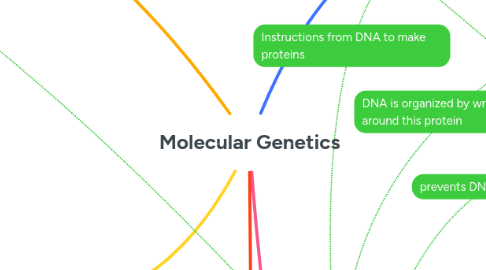
1. DNA studies
1.1. Meisher (1868)
1.1.1. Protein was though to be DNA as Hereditary material because they were complex and carried out important cell functions
1.1.2. Found acidic substance that contained phosphorus (nuclein)
1.2. Griffith (1928)
1.2.1. S-strain bacteria - causes disease but when heated s- strain died & caused no affect
1.2.1.1. transforming principle discovered as live R-strain and dead S-strain were mixed together caused the test subject to die. this lead to the discovery of transforming principle. transforming principle = cells take up the genetic material from their surroundings.
1.2.1.2. R-strain bacteria - doesn't cause disease
1.3. Avery, McLeod & McCarty (1944)
1.3.1. extracted & destroyed possible transforming substances (protein & DNA)
1.4. Chargaff (1950)
1.4.1. Didn't believe the complementary bases were the same ratio & discovered the ratios
1.5. Hershey & Chase (1952)
1.5.1. goal: prove DNA is the hereditary material
1.5.1.1. did this by bacteriophages; DNA contains PO4 -phosphorus- & protein coat contains sulfur. discovered that PO4 entered the cell
1.6. Wilkins & Franklin (1951)
1.6.1. Used c-ray crystallography to learn more about DNA. DNA is double helix
1.7. Watson & Crick
1.7.1. molecule must be antiparallel for it to be stable.
1.7.1.1. 3' end of 1st strand must have a OH group, 5' end must have a PO4
2. Proteins
2.1. made of many amino acids
2.1.1. Histones
2.2. Protein synthesis
2.2.1. Transcription
2.2.1.1. Initiation - RNA polymerase binds and unwinds DNA
2.2.1.2. Elongation - RNA polymerase binds to promoter & starts adding complementary strands to DNA template ( instead of U its A )
2.2.1.3. termination - pre-mRNA detaches from the DNA template then goes through modifications before it exits the nucleus
2.2.2. Translation
2.2.2.1. ribosomes read codons for amino acid sequences and makes the polypeptide strand
2.2.2.2. tRNA- has an anticodon, which corresponds with the mRNA strand and an amino acid at the end
2.2.3. Termination
2.2.3.1. once Ribosome read an end codon, everything detaches. free polypeptide chain will fold & join other polypeptides to create functional thing such as enzymes
3. Nitrogenous bases: adenine (A) guanine (G) thymine (T) Cytosine (C). RNA has Uracil (U) instead of thymine (T)
4. DNA replication
4.1. Mendelson & Sthal discovered that DNA replication must be semi conservative (semi conservative = original parent strand is blended with new strands)
4.2. Helicase enzyme - unwinds DNA strands
4.3. DNA polymerase - forms new strands in a 5' to 3' direction. DNA polymerase I - replaces RNA nucleotide U with T on the daughter strand
4.3.1. RNA primase enzyme (ribose sugar & 'U' base instead of 'T'
4.4. DNA Ligase - joins Okazaki fragments by forming phosphodiester bonds
4.5. Okazaki fragments
4.5.1. DNA polymerase III can't add continuous nucleotides in a 3' to 5' direction so they do it in chunks
5. DNA
5.1. instructions for the cell & located in the nucleus
5.2. composed of nucleotides that contain phosphate, deoxyribose sugar and nitrogenous base
5.3. Single stranded DNA - held together by phosphodiester bonds through a dehydration/condensation reaction
5.3.1. Double-stranded - connected by hydrogen bonds between complementary nitrogenous bases
5.3.1.1. Strands are antiparallel that travel in a 5'to3' and 3'to5'
5.4. Chromosomes
5.4.1. Telomeres - end of each chromosome to prevent chromosomes from connecting to each other
